Leveraging Energy Harvesting and Wake-Up Receivers for Long-Term Wireless Sensor Networks
Abstract
:1. Introduction
- A novel EM for EH-WSNs is proposed. Unlike most state-of-the-art EMs, the energy management strategy proposed in this work only requires the residual energy as an input, making it practically easy to implement on real hardware platforms.
- A novel MAC protocol, called SNW-MAC (Star Network WuRx-MAC) leveraging ULP WuRx for data-gathering star networks is proposed. SNW-MAC enables asynchronous communications, minimizes the cost of packet transmissions and allows error corrections. SNW-MAC significantly reduces the energy cost variability of packet transmissions, allowing accurate control of the consumed energy by the EM. Moreover, an analytical study of SNW-MAC scalability is presented.
- SNW-MAC and the proposed energy management scheme were implemented and evaluated in the field, using a state-of-the-art ULP WuRx [13]. The proposed scheme was evaluated in the context of indoor light energy harvesting through exhaustive experimentation.
- In order to achieve a fair evaluation of the proposed scheme, two state-of-the-art MAC protocols were also implemented on the same hardware and application scenario. Results show that ULP WuRx allow improved communication efficiency, which is exploited by the EM to achieve a higher throughput (up to more than double) compared with state-of-the-art schemes. To rigorously measure this improved energy efficiency in the context of data gathering WSNs, the Energy Utilization Coefficient (EUC) is defined and used as an evaluation metric.
2. Related Work
2.1. Energy Management for EH-WSNs
2.2. MAC Protocols Leveraging Wake-Up Receivers
3. Energy Management for an Energy-Harvesting Sensor Node
3.1. EBC Design
3.2. TC Design
3.3. Energy Utilization Coefficient
4. MAC Protocol Leveraging Wake-up Receivers
4.1. Design of SNW-MAC
4.2. Analytical Study of Scalability
5. Experimental Setup
5.1. Node Architecture
5.2. Ultra-Low Power Wake-Up Receiver
5.3. State-Of-The-Art MAC Protocols Used for Comparison
6. Experimental Results
6.1. Energy Consumption of the Wake-Up Receiver
6.2. Energy Microbenchmarks
6.3. Energy Consumption of the Sink
6.4. Evaluation on a Star Network
6.5. Evaluation under Variable Light Conditions
7. Conclusions
Author Contributions
Funding
Conflicts of Interest
References
- Rawat, P.; Singh, K.D.; Chaouchi, H.; Bonnin, J.M. Wireless sensor networks: A survey on recent developments and potential synergies. J. Supercomput. 2014, 68, 1–48. [Google Scholar] [CrossRef]
- Kansal, A.; Hsu, J.; Zahedi, S.; Srivastava, M.B. Power Management in Energy Harvesting Sensor Networks. ACM Trans. Embed. Comput. Syst. 2007, 6, 32. [Google Scholar] [CrossRef]
- Wu, T.Q.; Yang, H.C. On the Performance of Overlaid Wireless Sensor Transmission With RF Energy Harvesting. IEEE J. Sel. Areas Commun. 2015, 33, 1693–1705. [Google Scholar] [CrossRef]
- Yang, S.; Yang, X.; McCann, J.A.; Zhang, T.; Liu, G.; Liu, Z. Distributed Networking in Autonomic Solar Powered Wireless Sensor Networks. IEEE J. Sel. Areas Commun. 2013, 31, 750–761. [Google Scholar] [CrossRef]
- Gorlatova, M.; Sarik, J.; Grebla, G.; Cong, M.; Kymissis, I.; Zussman, G. Movers and Shakers: Kinetic Energy Harvesting for the Internet of Things. IEEE J. Sel. Areas Commun. 2015, 33, 1624–1639. [Google Scholar] [CrossRef]
- Rault, T.; Bouabdallah, A.; Challal, Y. Energy Efficiency in Wireless Sensor Networks: A Top-Down Survey. Comput. Netw. 2014, 67, 104–122. [Google Scholar] [CrossRef]
- Schurge, C.; Tsiats, V.; Ganeriw, S.; Srivasta, M. Optimizing sensor networks in the energy-latency-density design space. IEEE Trans. Mob. Comput. 2002, 1, 70–80. [Google Scholar] [CrossRef]
- Ibara, E.; Antonopoulos, A.; Kartsakli, E.; Verikoukis, C. HEH-BMAC: Hybrid polling MAC protocol for WBANs operated by human energy harvesting. Telecommun. Syst. 2015, 58, 111–124. [Google Scholar] [CrossRef] [Green Version]
- Tang, L.; Sun, Y.; Gurewitz, O.; Johnson, D.B. PW-MAC: An Energy-Efficient Predictive-Wakeup MAC Protocol for Wireless Sensor Networks. In Proceedings of the 2011 IEEE Conference on Computer Communications (INFOCOM), Shanghai, China, 10–15 April 2011; pp. 1305–1313. [Google Scholar]
- Esteves, V.; Antonopoulos, A.; Kartsakli, E.; Puig-Vidal, M.; Miribel-Català, P.; Verikoukis, C. Cooperative Energy Harvesting-Adaptive MAC Protocol for WBANs. Sensors 2015, 15, 12635–12650. [Google Scholar] [CrossRef] [PubMed] [Green Version]
- Mazloum, N.S.; Edfors, O. Performance Analysis and Energy Optimization of Wake-up Receiver Schemes for Wireless Low-Power Applications. IEEE Trans. Wirel. Commun. 2014, 13, 7050–7061. [Google Scholar] [CrossRef]
- Ammar, Y.; Bdiri, S.; Derbel, F. An Ultra-Low Power Wake Up Receiver with Flip Flops Based Address Decoder. In Proceedings of the International Multi-Conference on Systems, Signals and Devices (SSD), Mahdia, Tunisia, 16–19 March 2015; pp. 1–5. [Google Scholar]
- Magno, M.; Jelicic, V.; Srbinovski, B.; Bilas, V.; Popovici, E.; Benini, L. Design, Implementation, and Performance Evaluation of a Flexible Low-Latency Nanowatt Wake-up Radio Receiver. IEEE Trans. Ind. Inform. 2016, 12, 633–644. [Google Scholar] [CrossRef]
- Oller, J.; Demirkol, I.; Casademont, J.; Paradells, J.; Gamm, G.U.; Reindl, L. Performance Evaluation and Comparative Analysis of SubCarrier Modulation Wake-up Radio Systems for Energy-Efficient Wireless Sensor Networks. Sensors 2014, 14, 22–51. [Google Scholar] [CrossRef] [PubMed] [Green Version]
- Oller, J.; Demirkol, I.; Casademont, J.; Paradells, J. Design, Development, and Performance Evaluation of a Low-cost, Low-power Wake-up Radio System for Wireless Sensor Networks. ACM Trans. Sens. Netw. 2013, 10, 11. [Google Scholar] [CrossRef]
- Chen, L.; Warner, J.; Yung, P.L.; Zhou, D.; Heinzelman, W.; Demirkol, I.; Muncuk, U.; Chowdhury, K.; Basagni, S. REACH2-Mote: A Range-Extending Passive Wake-up Wireless Sensor Node. ACM Trans. Sens. Netw. 2015, 11, 64. [Google Scholar] [CrossRef] [Green Version]
- Spenza, D.; Magno, M.; Basagni, S.; Benini, L.; Paoli, M.; Petrioli, C. Beyond Duty Cycling: Wake-Up Radio with Selective Awakenings for Long-Lived Wireless Sensing Systems. In Proceedings of the 2015 IEEE Conference on Computer Communications (INFOCOM), Hong Kong, China, 26 April–1 May 2015; pp. 522–530. [Google Scholar]
- Sutton, F.; Buchli, B.; Beutel, J.; Thiele, L. Zippy: On-Demand Network Flooding. In Proceedings of the ACM Conference on Embedded Networked Sensor Systems (SenSys), Seoul, Korea, 1–4 November 2015; pp. 45–58. [Google Scholar]
- Ameen, M.A.; Ullah, N.; Chowdhury, M.S.; Kwak, K. A MAC Protocol for Body Area Networks using Out-of-Band Radio. In Proceedings of the 11th European Wireless Conference—Sustainable Wireless Technologies (European Wireless), Vienna, Austria, 27–29 April 2011. [Google Scholar]
- Ramachandran., V.R.K.; van der Zwaag, B.J.; Meratnia, N.; Havinga, P. Implantable body sensor network MAC protocols using wake-up radio—Evaluation in animal tissue. In Proceedings of the 9th International Symposium on Medical Information and Communication Technology (ISMICT), Kamakura, Japan, 24–26 March 2015. [Google Scholar]
- Magno, M.; Marinkovic, S.; Brunelli, D.; Popovici, E.; O’Flynn, B.; Benini, L. Smart Power Unit with Ultra Low Power Radio Trigger Capabilities for Wireless Sensor Networks. In Proceedings of the Conference on Design, Automation and Test in Europe (DATE), Dresden, Germany, 12–16 March 2012. [Google Scholar]
- Srbinovska, M.; Gavrovski, C.; Dimcev, V.; Krkoleva, A.; Borozan, V. Environmental parameters monitoring in precision agriculture using wireless sensor networks. J. Clean. Prod. 2015, 88, 297–307. [Google Scholar] [CrossRef]
- Wang, X.; Ma, J.J.; Wang, S.; Bi, D.W. Prediction-based Dynamic Energy Management in Wireless Sensor Networks. Sensors 2007, 7, 251–266. [Google Scholar] [CrossRef]
- Castagnetti, A.; Pegatoquet, A.; Belleudy, C.; Auguin, M. A Framework for Modeling and Simulating Energy Harvesting WSN Nodes with Efficient Power Management Policies. EURASIP J. Embed. Syst. 2012, 8. [Google Scholar] [CrossRef] [Green Version]
- Le, T.N.; Pegatoquet, A.; Berder, O.; Sentieys, O. Energy-Efficient Power Manager and MAC Protocol for Multi-Hop Wireless Sensor Networks Powered by Periodic Energy Harvesting Sources. IEEE Sens. J. 2015, 15, 7208–7220. [Google Scholar] [CrossRef]
- Ait Aoudia, F.; Gautier, M.; Berder, O. GRAPMAN: Gradual Power Manager for Consistent Throughput of Energy Harvesting Wireless Sensor Nodes. In Proceedings of the IEEE 26th Annual International Symposium on Personal, Indoor, and Mobile Radio Communications (PIMRC), Hong Kong, China, 30 August–2 September 2015. [Google Scholar]
- Vigorito, C.M.; Ganesan, D.; Barto, A.G. Adaptive Control of Duty Cycling in Energy-Harvesting Wireless Sensor Networks. In Proceedings of the 4th Annual IEEE Communications Society Conference on Sensor, Mesh and Ad Hoc Communications and Networks (SECON), San Diego, CA, USA, 18–21 June 2007. [Google Scholar]
- Le, T.N.; Sentieys, O.; Berder, O.; Pegatoquet, A.; Belleudy, C. Power Manager with PID Controller in Energy Harvesting Wireless Sensor Networks. In Proceedings of the IEEE International Conference on Green Computing and Communications (GreenCom), Besancon, France, 20–23 November 2012. [Google Scholar]
- Peng, S.; Low, C.P. Prediction free energy neutral power management for energy harvesting wireless sensor nodes. Ad Hoc Netw. 2014, 13, 351–367. [Google Scholar] [CrossRef]
- Ait Aoudia, F.; Gautier, M.; Berder, O. Fuzzy power management for energy harvesting Wireless Sensor Nodes. In Proceedings of the IEEE International Conference on Communications (ICC), Kuala Lumpur, Malaysia, 22–27 May 2016. [Google Scholar] [CrossRef]
- Ibara, E.; Antonopoulos, A.; Kartsakli, E.; Rodrigues, J.P.C.; Verikoukis, C. QoS-Aware Energy Management in Body Sensor Nodes Powered by Human Energy Harvesting. IEEE Sens. J. 2016, 16, 542–549. [Google Scholar] [CrossRef]
- Piorno, J.R.; Bergonzini, C.; Atienza, D.; Rosing, T.S. Prediction and Management in Energy Harvested Wireless Sensor Nodes. In Proceedings of the 1st International Conference on Wireless Communication, Vehicular Technology, Information Theory and Aerospace Electronic Systems Technology. (Wireless VITAE), Aalborg, Denmark, 17–20 May 2009. [Google Scholar]
- Renner, C.; Unterschütz, S.; Turau, V.; Römer, K. Perpetual Data Collection with Energy-Harvesting Sensor Networks. ACM Trans. Sens. Netw. 2014, 11, 12. [Google Scholar] [CrossRef]
- Margolies, R.; Gorlatova, M.; Sarik, J.; Stanje, G.; Zhu, J.; Miller, P.; Szczodrak, M.; Vigraham, B.; Carloni, L.; Kinget, P.; Kymissis, I.; Zussman, G. Energy-Harvesting Active Networked Tags (EnHANTs): Prototyping and Experimentation. ACM Trans. Sens. Netw. 2015, 11, 62:1–62:27. [Google Scholar] [CrossRef]
- Huang, P.; Xiao, L.; Soltani, S.; Mutka, M.W.; Xi, N. The Evolution of MAC Protocols in Wireless Sensor Networks: A Survey. IEEE Commun. Surv. Tutor. 2013, 15, 101–120. [Google Scholar] [CrossRef]
- Fafoutis, X.; Dragoni, N. Analytical comparison of MAC schemes for Energy Harvesting—Wireless Sensor Networks. In Proceedings of the Ninth International Conference on Networked Sensing Systems (INSS), Antwerp, Belgium, 11–14 June 2012. [Google Scholar]
- Lin, E.Y.; Rabaey, J.; Wolisz, A. Power-efficient rendezvous schemes for dense wireless sensor networks. In Proceedings of the 2014 IEEE International Conference on Communications (ICC), Paris, France, 20–24 June 2004. [Google Scholar]
- Le, T.N.; Magno, M.; Pegatoquet, A.; Berder, O.; Sentieys, O.; Popovici, E. Ultra Low Power Asynchronous MAC Protocol Using Wake-up Radio for Energy Neutral WSN. In Proceedings of the 1st ACM International Workshop on Energy Neutral Sensing Systems (ENSSys), Rome, Italy, 13 November 2013. [Google Scholar]
- Mahlknecht, S.; Durante, M.S. WUR-MAC: Energy efficient Wakeup Receiver based MAC Protocol. In Proceedings of the 8th IFAC International Conference on Fieldbuses and Networks in Industrial and Embedded Systems, Ansan, Korea, 20–22 May 2009. [Google Scholar]
- Ait Aoudia, F.; Gautier, M.; Berder, O. OPWUM: Opportunistic MAC Protocol Leveraging Wake-up Receivers in WSNs. J. Sens. 2016, 2016, 6263719. [Google Scholar] [CrossRef] [Green Version]
- Nawaz, S.; Hassan, S.A.; Zaidi, S.A.R.; Ghogho, M. Throughput and energy efficiency of two-tier cellular networks: Massive MIMO overlay for small cells. In Proceedings of the International Wireless Communications and Mobile Computing Conference (IWCMC), Paphos, Cyprus, 5–9 September 2016; pp. 874–879. [Google Scholar]
- Huang, C.; Tang, Y. On the Energy Efficiency and Effective Throughput Tradeoff of Fading Channels. IEEE Trans. Veh. Technol. 2016, 65, 2758–2762. [Google Scholar] [CrossRef]
- Ait Aoudia, F.; Gautier, M.; Magno, M.; Berder, O.; Benini, L. SNW-MAC: An Asynchronous Protocol Leveraging Wake-up Receivers for Data Gathering in Star Networks. In Proceedings of the EAI International Conference on Sensor Systems and Software (S-cube), Nice, France, 1–2 December 2016. [Google Scholar]
- Jelicic, V.; Magno, M.; Brunelli, D.; Bilas, V.; Benini, L. Analytic Comparison of Wake-up Receivers for WSNs and Benefits over the Wake-on Radio Scheme. In Proceedings of the 7th ACM Workshop on Performance Monitoring and Measurement of Heterogeneous Wireless and Wired Networks (PM2HW2N), Paphos, Cyprus, 21–22 October 2012. [Google Scholar]
- Le, T.N.; Pegatoquet, A.; Berder, O.; Sentieys, O.; Carer, A. Energy-Neutral Design Framework for Supercapacitor-Based Autonomous Wireless Sensor Networks. ACM J. Emerg. Technol. Comput. Syst. 2015, 12, 19:1–19:21. [Google Scholar] [CrossRef]
- Kailas, A.; Brunelli, D.; Weitnauer, M.A. Comparison of Energy Update Models for Wireless Sensor Nodes with Supercapacitors. In Proceedings of the 1st International Workshop on Energy Neutral Sensing Systems (ENSSys), Rome, Italy, 13 November 2013. [Google Scholar]
- Berder, O.; Sentieys, O. PowWow: Power Optimized Hardware/Software Framework for Wireless Motes. In Proceedings of the International Conference on Architecture of Computing Systems (ARCS), Hannover, Germany, 22–23 February 2010. [Google Scholar]
- Klues, K.; Hackmann, G.; Chipara, O.; Lu, C. A Component-based Architecture for Power-efficient Media Access Control in Wireless Sensor Networks. In Proceedings of the 5th International Conference on Embedded Networked Sensor Systems (SenSys), Sydney, Australia, 6–9 November 2007. [Google Scholar]
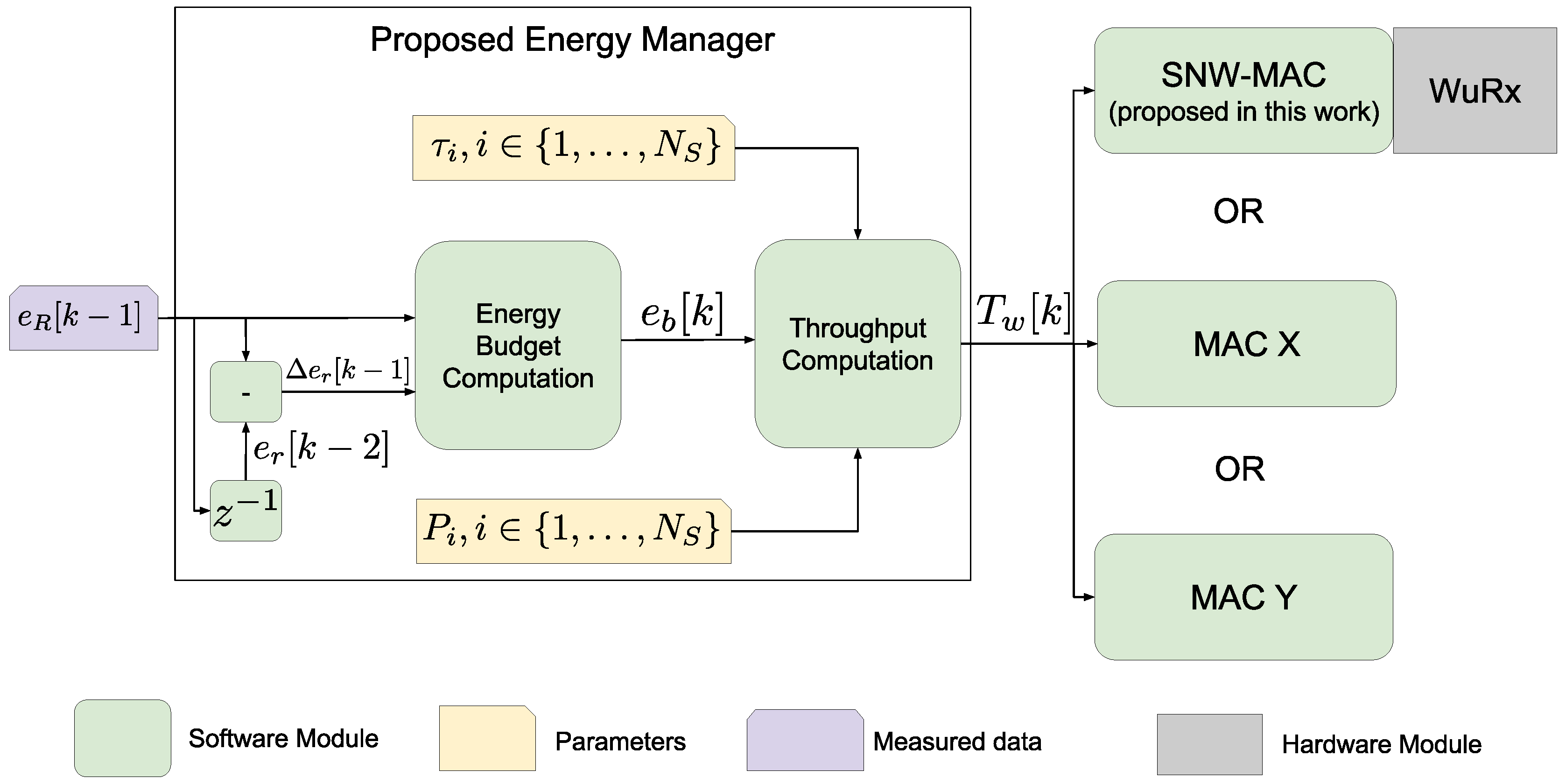

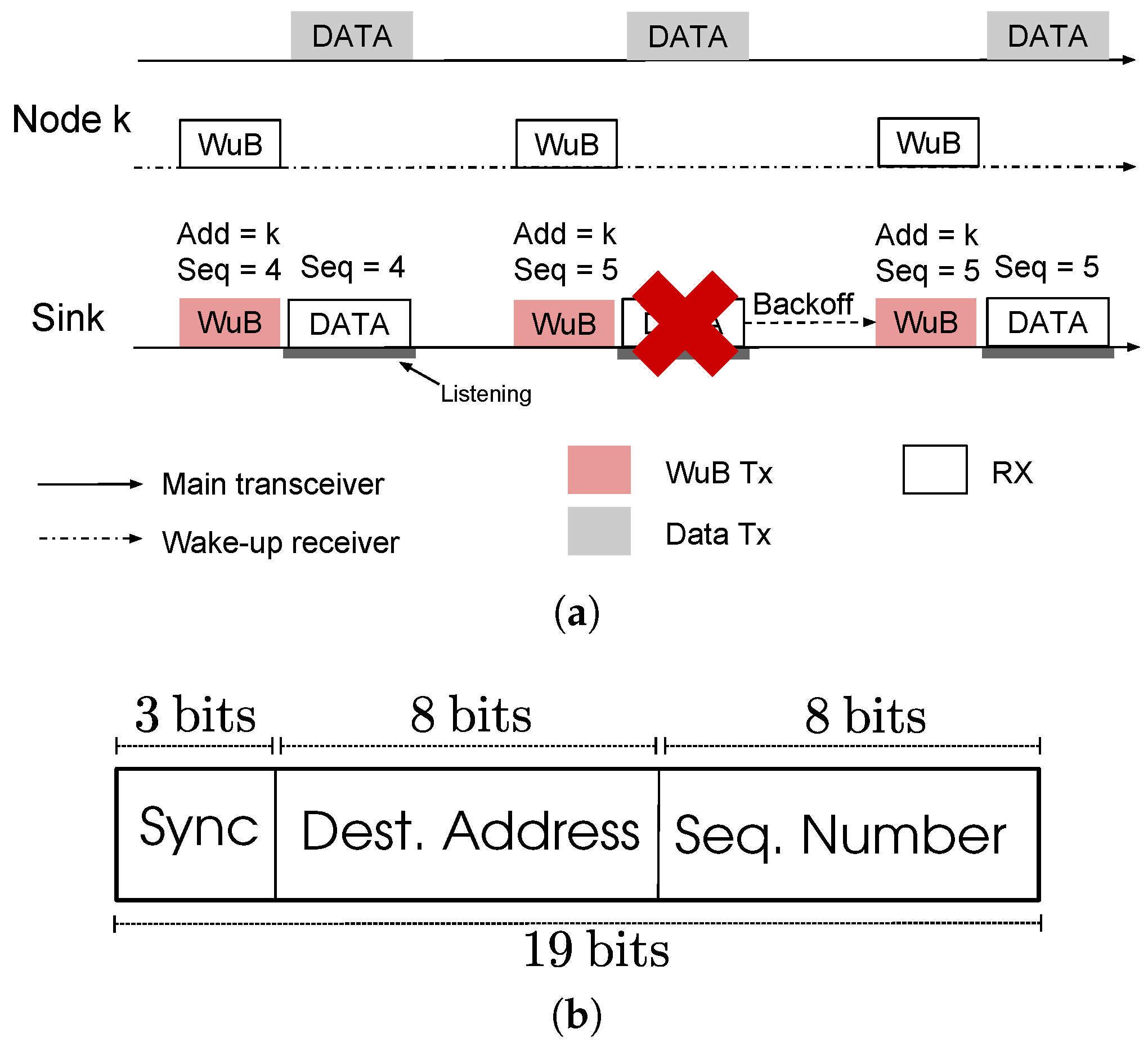
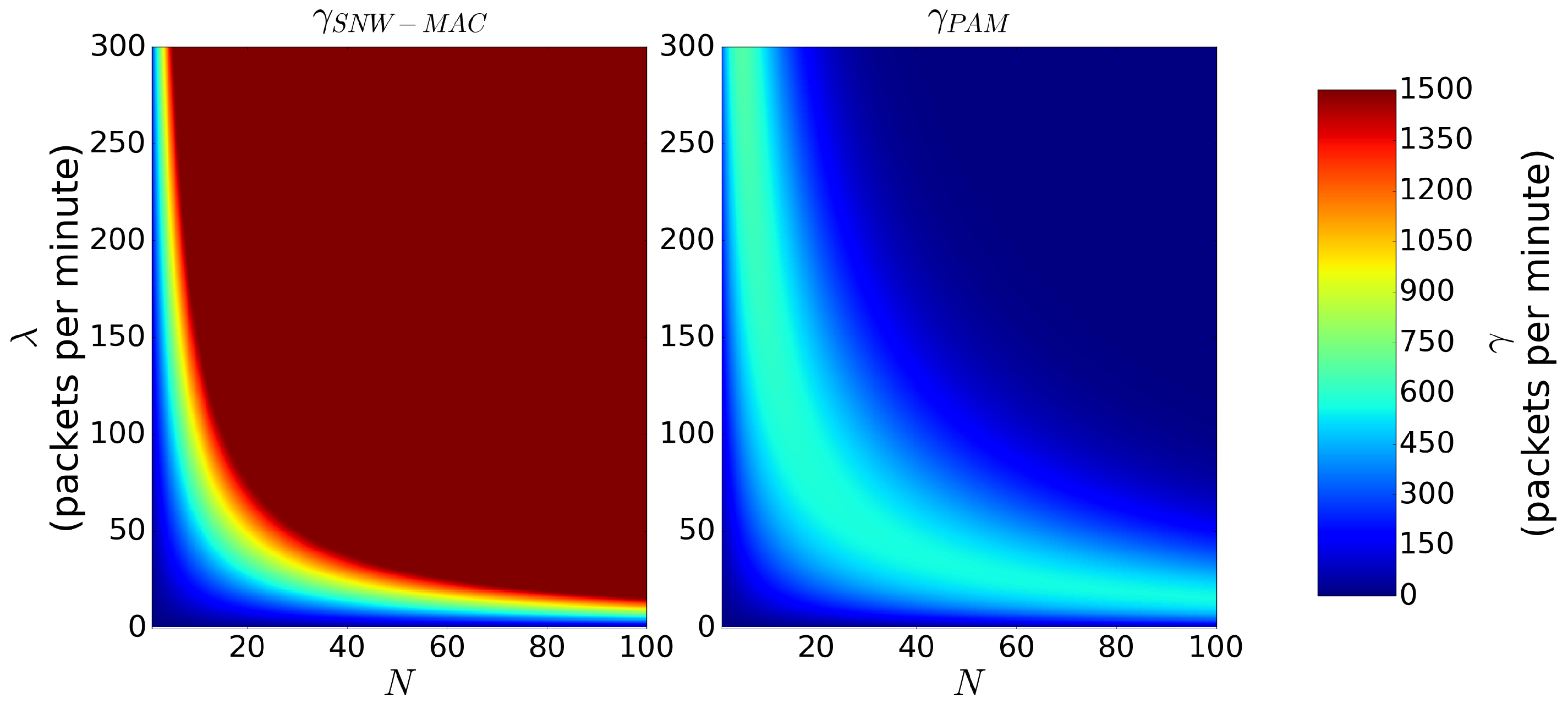
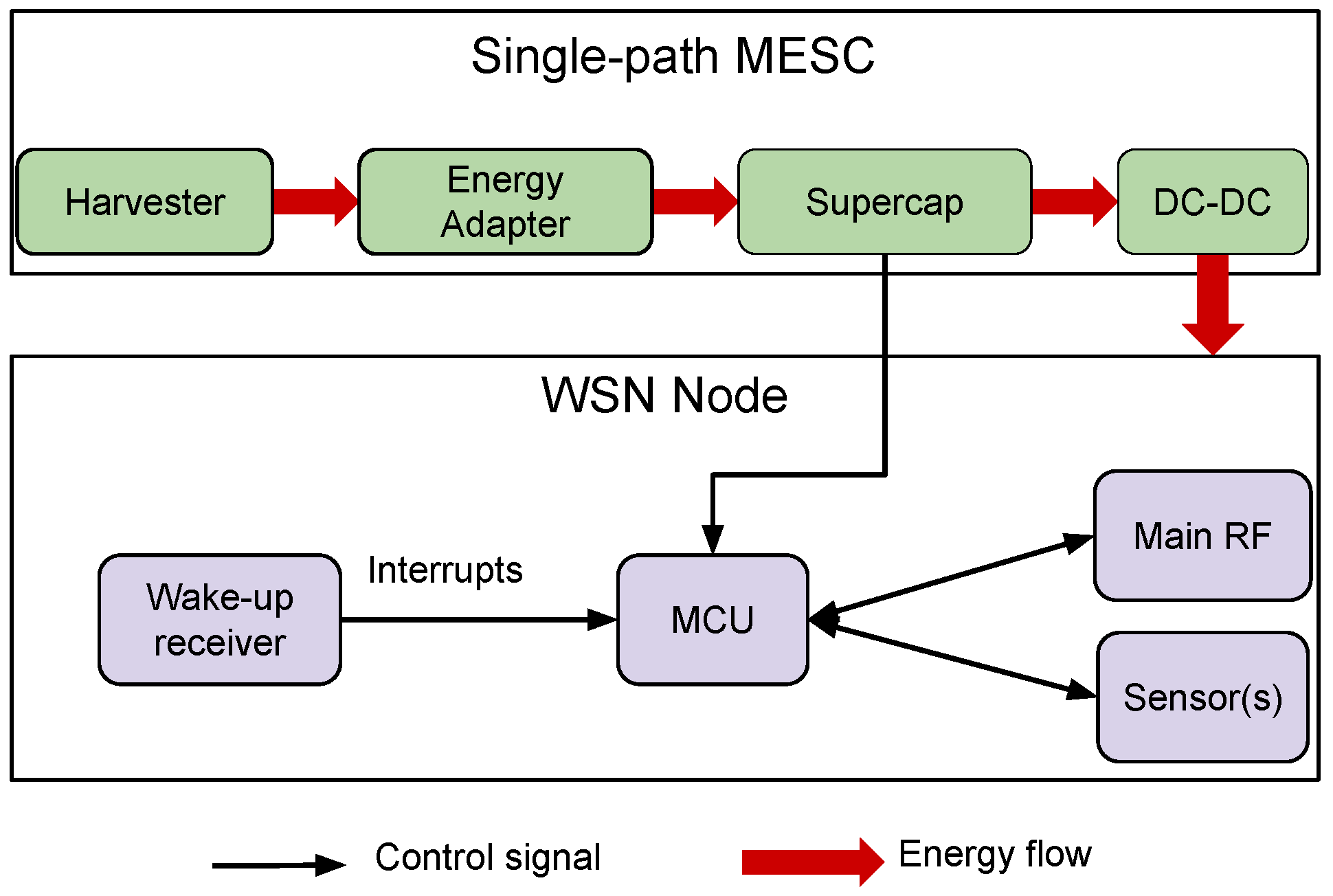
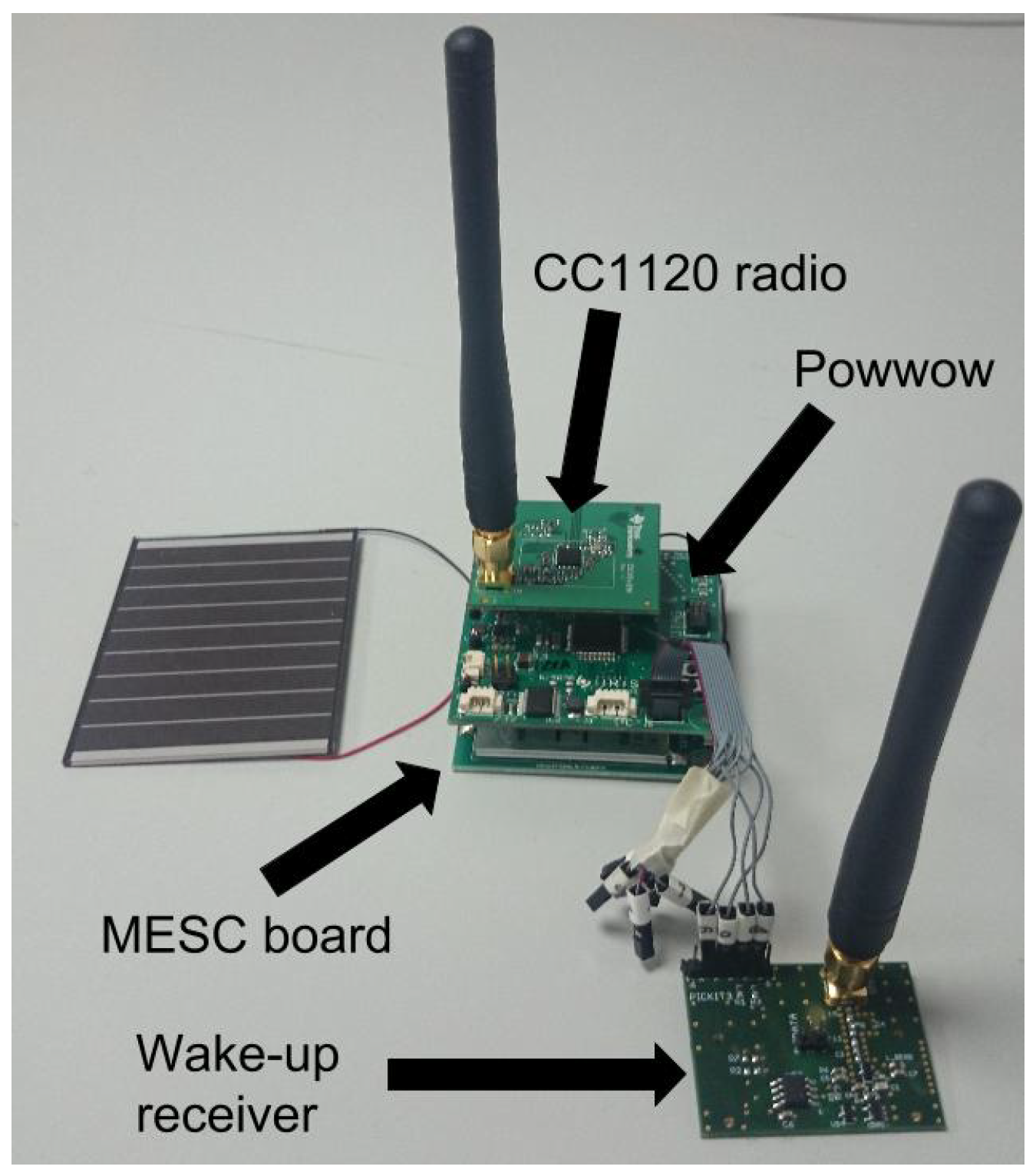
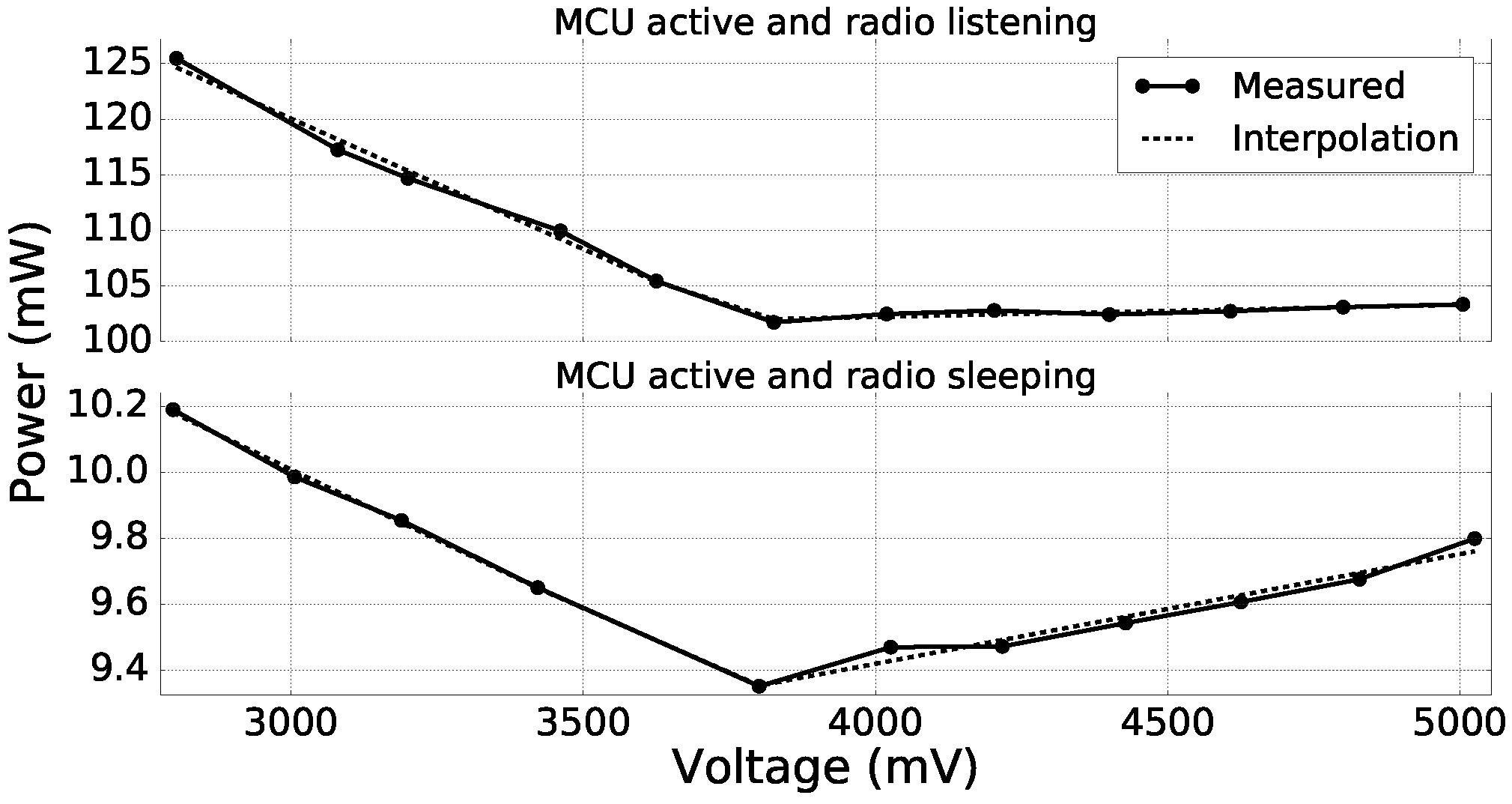

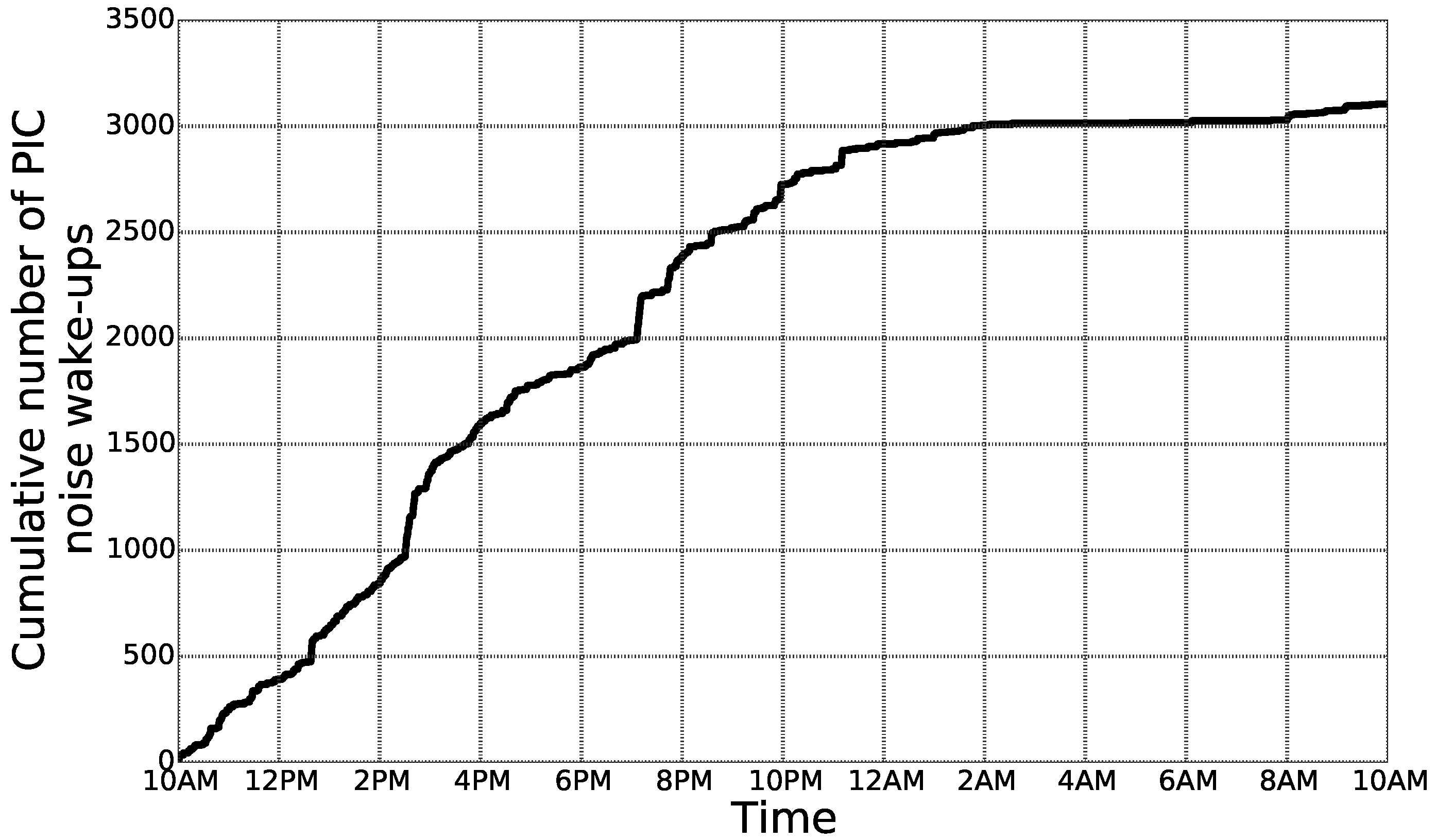
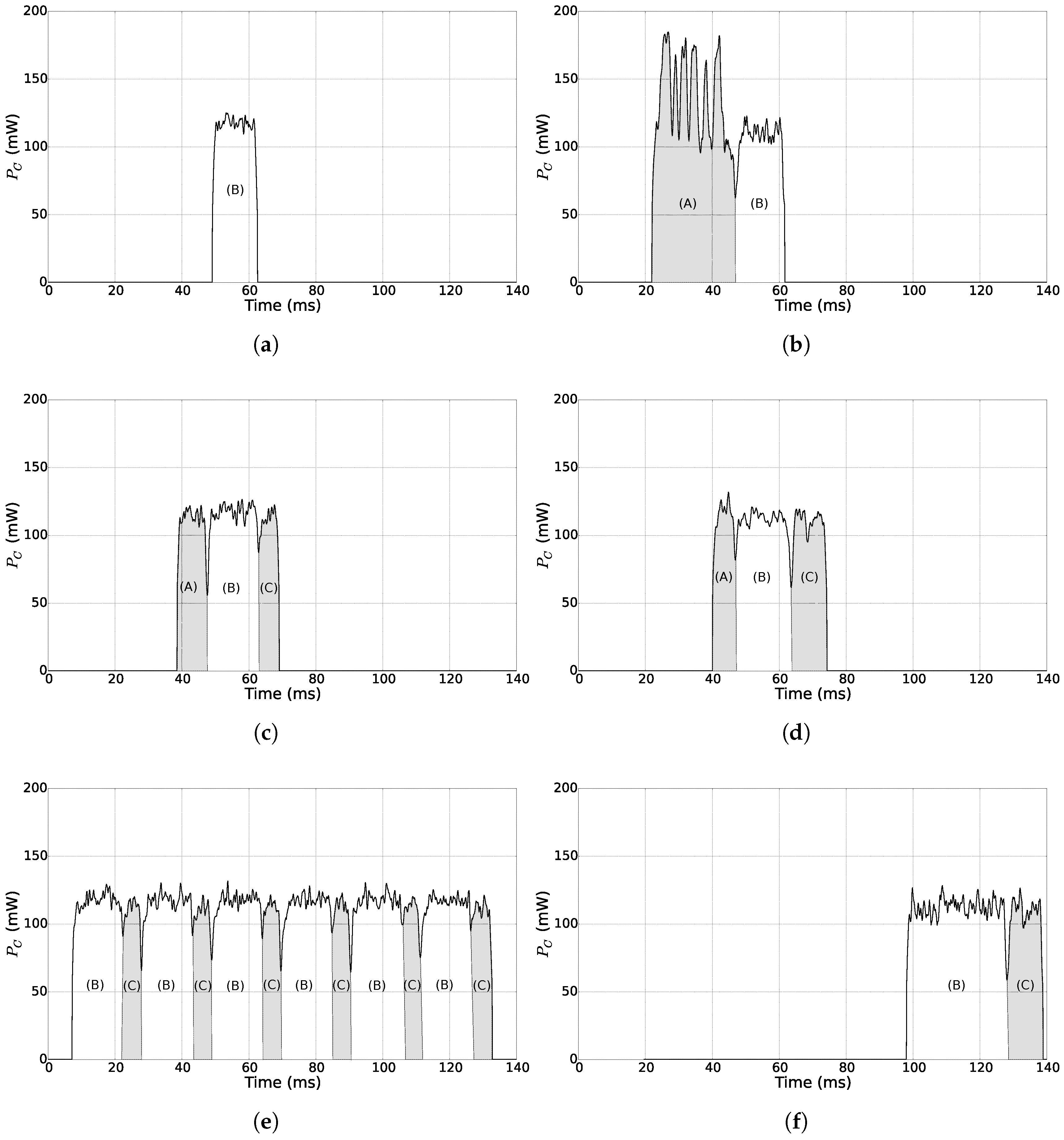
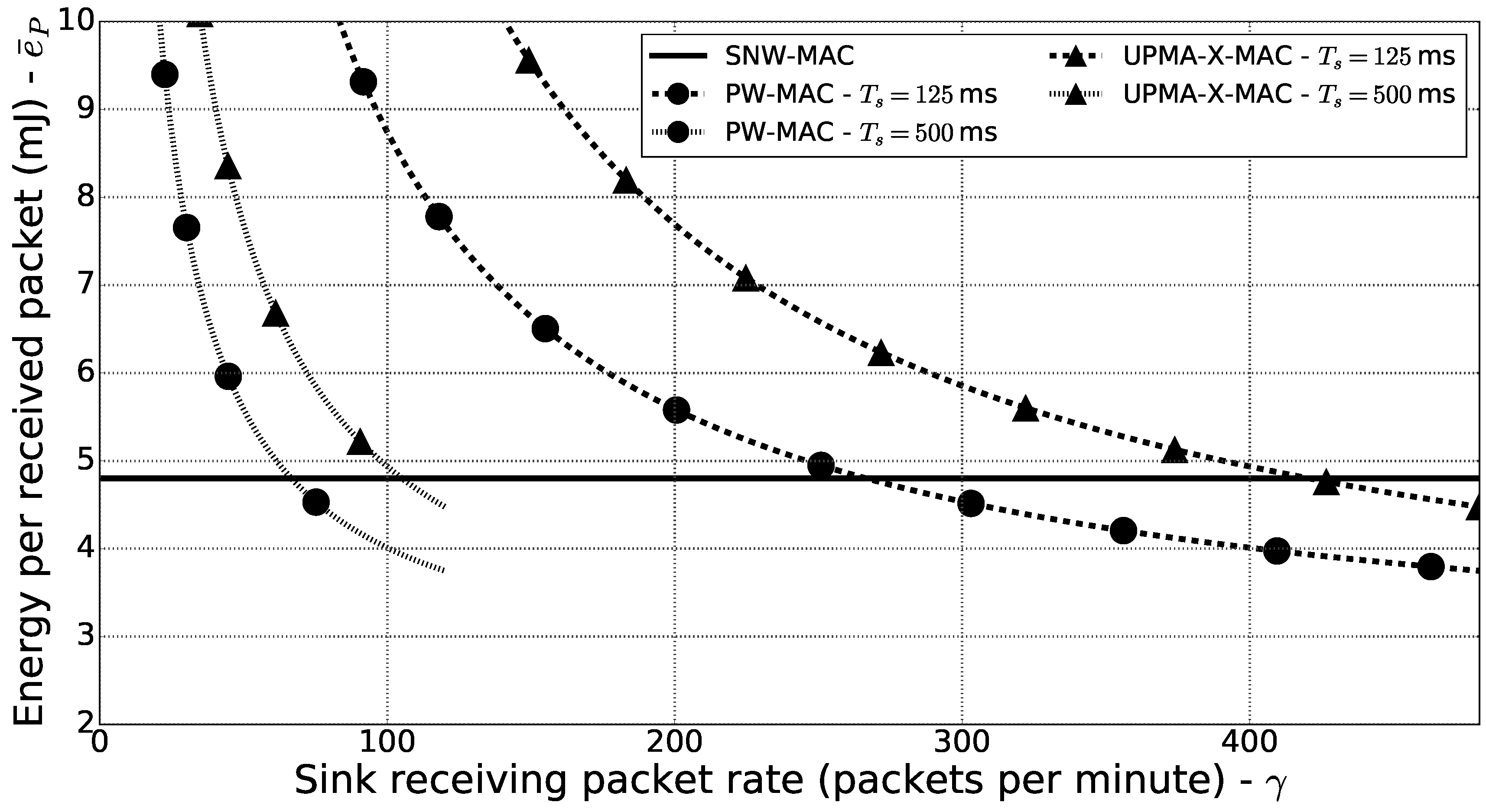
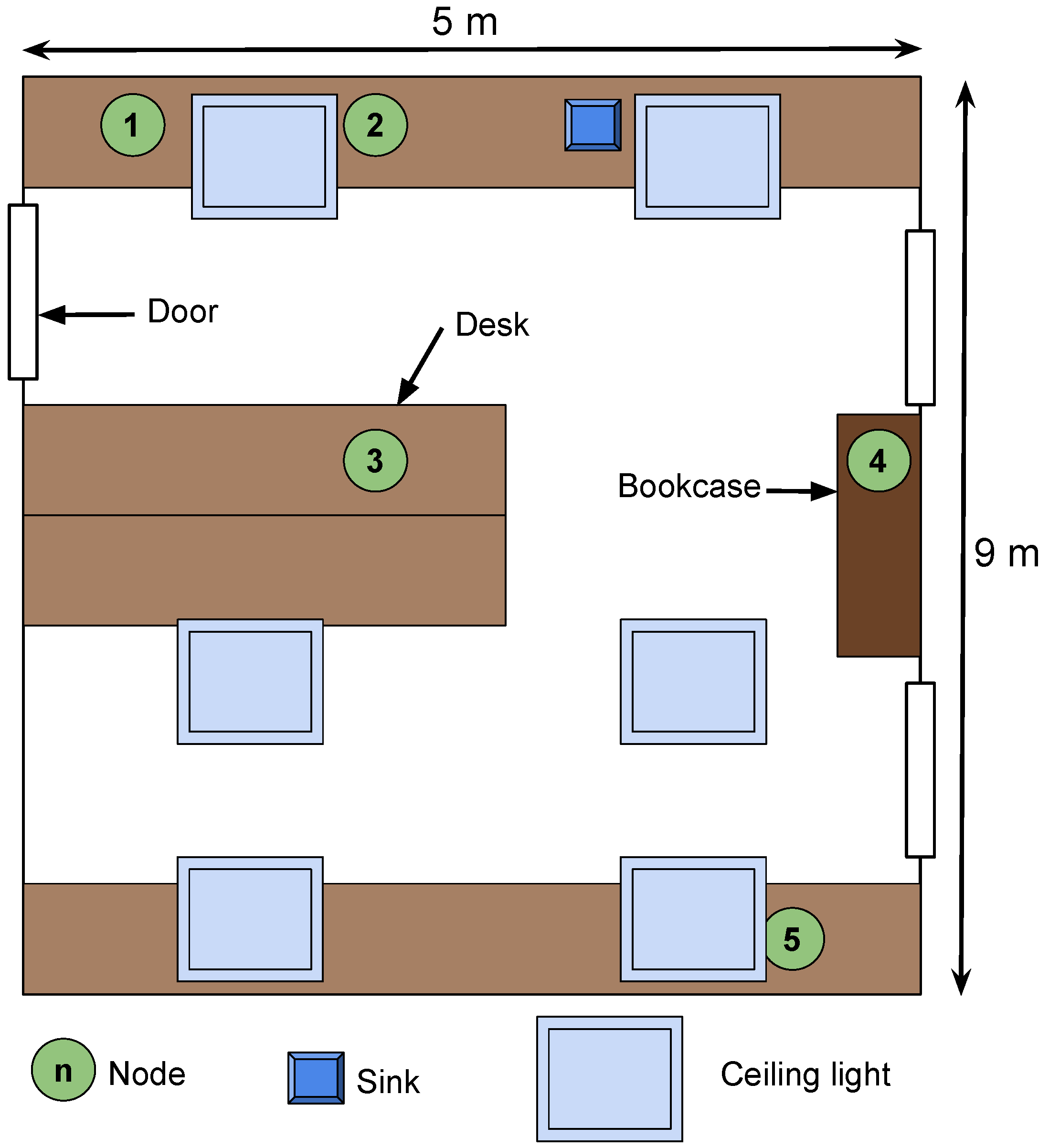
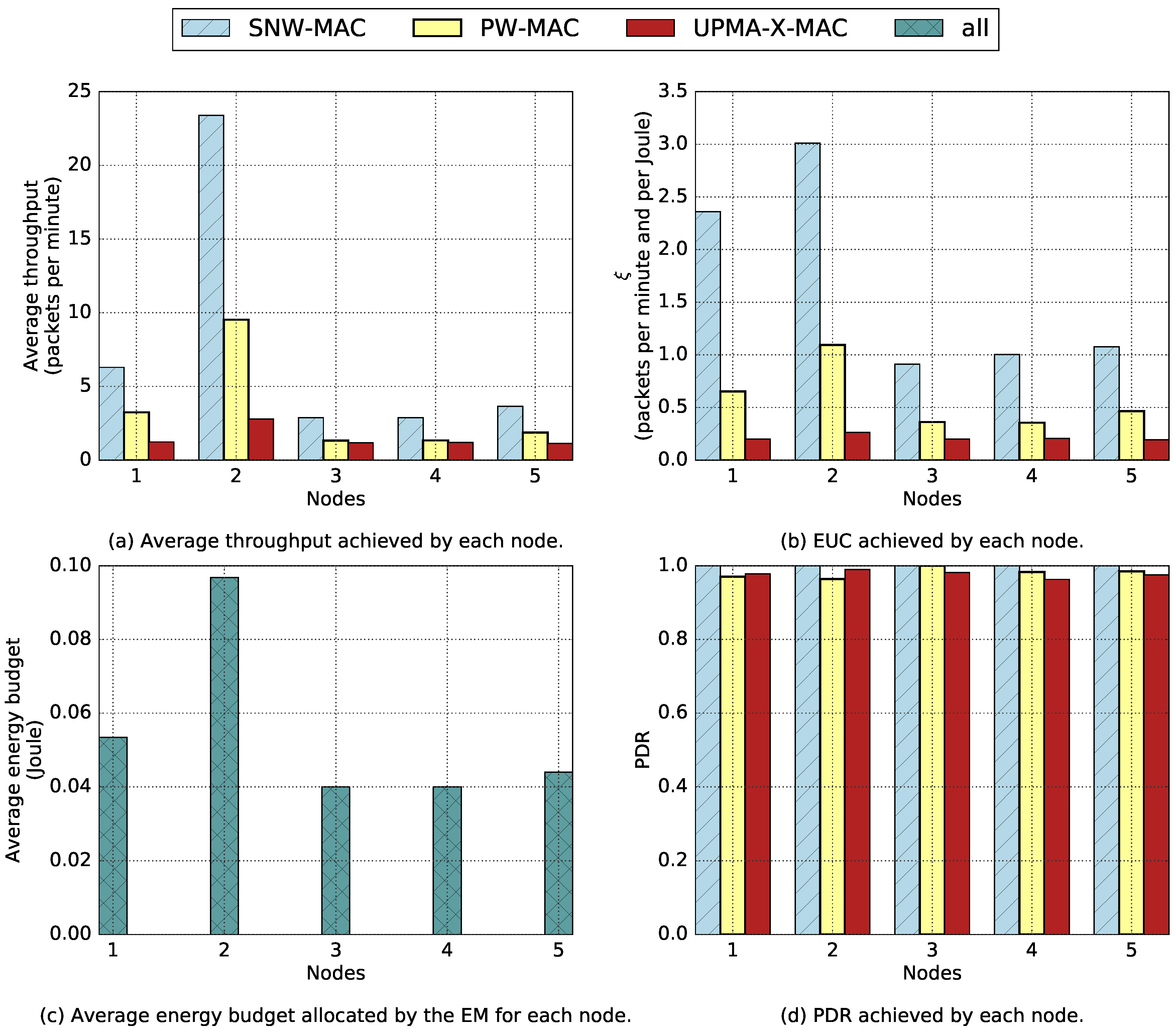

| Parameters | Values | |
|---|---|---|
| MAC | Sink wake-up interval (UPMA-X-MAC and PW-MAC) | ms |
| Maximum number of retransmissions | 2 | |
| PHY | WuB bitrate | kbps |
| Data/ACK/beacon bitrate | kbps | |
| WuB transmission power | dBm | |
| Data/ACK/beacon transmission power | dBm | |
| EBC | ||
| mJ | ||
| J | ||
| J | ||
| J | ||
| J | ||
| J | ||
| Protocol | H (Joule) | (Packets Per Minute and Per Joule) |
|---|---|---|
| UPMA-X-MAC | 0.0125 | 0.666 |
| PW-MAC | 0.00313 | 2.660 |
| SNW-MAC | 0.00135 | 6.156 |
© 2018 by the authors. Licensee MDPI, Basel, Switzerland. This article is an open access article distributed under the terms and conditions of the Creative Commons Attribution (CC BY) license (http://creativecommons.org/licenses/by/4.0/).
Share and Cite
Ait Aoudia, F.; Gautier, M.; Magno, M.; Berder, O.; Benini, L. Leveraging Energy Harvesting and Wake-Up Receivers for Long-Term Wireless Sensor Networks. Sensors 2018, 18, 1578. https://doi.org/10.3390/s18051578
Ait Aoudia F, Gautier M, Magno M, Berder O, Benini L. Leveraging Energy Harvesting and Wake-Up Receivers for Long-Term Wireless Sensor Networks. Sensors. 2018; 18(5):1578. https://doi.org/10.3390/s18051578
Chicago/Turabian StyleAit Aoudia, Fayçal, Matthieu Gautier, Michele Magno, Olivier Berder, and Luca Benini. 2018. "Leveraging Energy Harvesting and Wake-Up Receivers for Long-Term Wireless Sensor Networks" Sensors 18, no. 5: 1578. https://doi.org/10.3390/s18051578





